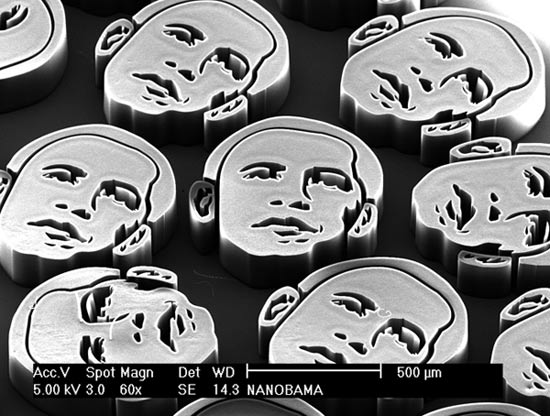Engineers Create 'Nanobamas'

President-elect Barack Obama's image looms larger than ever in the media these days, but now his face has been rendered in 3-D portraits smaller than a grain of salt, using nanotechnology.
The mini-Barack Obamas were made by John Hart, an engineering professor at the University of Michigan, who dubbed them "nanobamas."
Each nanobama contains about 150 million carbon nanotubes stacked vertically like trees in a forest. A carbon nanotube is an extraordinarily strong hollow cylinder about 1/50,000th the width of a human hair.
Hart created the "nano art" to raise awareness of nanotechnology and science.
"Developments like this are an excellent way to bring the concepts of nanotechnology to a broader audience," said Hart, who made the portraits with his colleagues by working late on a Friday evening. "Also, we thought it would be fun."
To create the nanobamas, the researchers converted Shepard Fairey's popular red, white and blue poster of Barack Obama into a line drawing. They shrunk it and printed it on a glass plate with a laser to create a mask. They shined ultraviolet light through the masked glass plate onto a silicon wafer to create the pattern. Then they grew the carbon nanotubes on the pattern, using a high-temperature chemical reaction.
The researchers photographed the nanobamas with an electron microscope. The faces are half a millimeter in size.
Sign up for the Live Science daily newsletter now
Get the world’s most fascinating discoveries delivered straight to your inbox.
Beyond nano art, carbon nanotubes could be used in solar cells and batteries, new methods of diagnosing and treating disease, next-generation computer processors and memory, and stronger lightweight materials. Hart's Mechanosynthesis Group focuses on studying how to make nanostructures like nanotubes, and how to use these small-scale building blocks in electronics, energy devices and high-performance materials.
Nanotechnology might come with risks, and some researchers are investigating the potential effects of nanoparticles on health and the environment. Some have called for the technology to be regulated.
- Listen to the World's First Carbon Nanotube Radio
- Nano Sports: The 2-Millimeter Dash and Invisible Soccer
- Images: Micromachines











